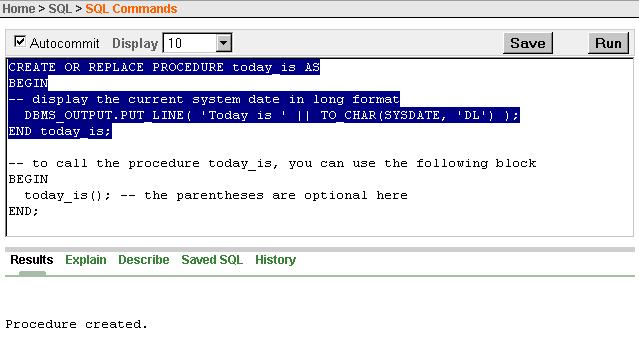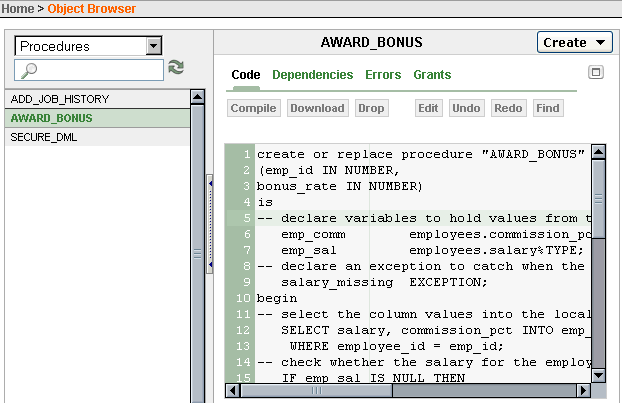Which Best Describes the Use of a Stored Procedure
My stored procedure best practices checklist. Stored procedures provide faster code execution and reduce network traffic.

5 Using Procedures Functions And Packages
Copy and paste the following example into the query window and click ExecuteThis example creates the same stored procedure as above using a different procedure name.

. In Object Explorer connect to an instance of Database Engine. Once the stored procedure we just need to call the procedure to make use of it. In this session let us learn more about the stored procedure and how it is used and called for execution.
When developing stored procedures there seems to be a lot of emphasis on get it done fast Which means type all lower case pay little attention to formatting and sometimes throw best. Describes how to execute a stored procedure. A stored procedure is a group of one or more pre-compiled SQL statements into a logical unit.
Stored procedures are simply T-SQL queries that are stored. Grant Permissions on a Stored Procedure. The CREATE SOURCED PROCEDURE statement defines a procedure that is based on another procedure in a federated database C.
Delete a Stored Procedure. Stored procedures are defined as a block or body of numerous lines of text. A specific type of subroutine that can be available for the applications and that will access the Relational type od Database is called Stores Procedure.
It is a subroutine or a subprogram in the common computing language that has been created and stored in the database. It is nothing but the group of SQL statements that accepts some input in the form of parameters and performs some task and may or may not returns a. They allow modular programming.
This means that it will execute a lot faster than sending a query from your application to the database. To create a procedure in Query Editor. Execute a Stored Procedure.
A stored procedure is a prepared SQL code that you can save so the code can be reused over and over again. People often wonder what are the real differences between User Defined Functions UDF or simply functions and stored procedures or just procedures. There are three types of stored procedures which can be deployed.
The stored Procedure can include the validation of the data or the differ. IBM Netezza provides a block-quoting mechanism to help ease the definition of the procedure body and to make the content more readable for debugging and learning. The opportunity to couple the set-based power of SQL with the iterative and conditional processing control of code.
Describes how to recompile a stored. And even more so from a performance standpoint you will need to ensure that your queries and the underlying data structures match in a manner that allow for good performance. To understand differences between functions and stored procedures in SQL Server you can refer to this article.
Describes how to return data from a stored procedure to an application. A stored procedure is a SQL code which is saved and can be reused. You can also pass parameters to a stored procedure so that the stored procedure can act based on the parameter values that is passed.
From the File menu click New Query. It is stored as an object inside the database server. Stored procedures are parsed and optimised as soon as they are created and the stored procedure is cached.
So if you have an SQL query that you write over and over again save it as a stored procedure and then just call it to execute it. The best description Ive found for a stored procedure is that its a set of instructions written in the Transact-SQL T-SQL language and compiled and executed within a relational database. This is part of more than a decade of posts involving Bad Habits and Best Practices.
The topics in this section explain how. Procedure_name for example. Stored procedures are database objects meaning that they are created in a specified database and schema.
Stored Procedures are created to perform one or more DML operations on Database. Stored procedures have been viewed as the de facto standard for applications to access and manipulate database information through the use of codified methods or procedures This is largely due to what they offer developers. So whenever you need to execute the query instead of calling it you can just call the stored procedure.
Therefore becoming more familiar with T-SQL and the various functions and syntaxes is really what you need to do. Built-in functions cannot be modified where as you can. See the full index.
Stored procedures allow you to write procedural code that executes SQL. In SQL Server we usually come across queries tables views stored procedures and functions. There are two types of functions.
SQL procedures external procedures and sourced procedures D. Describes how to grant permissions on a stored procedure. The stored procedure accepts the parameters and executes the T-SQL statements in the procedure returns the result set if any.
Expert Answer Stored Procedure. A stored procedure can be parameterized or a normal procedure. A Stored Procedure is a type of code in SQL that can be stored for later use and can be used many times.
The benefits of using stored procedures in SQL Server rather than application code stored locally on client computers include. They have a fully-qualified name defined by their namespace in the form of db. SQL Server stored procedure is a batch of statements grouped as a logical unit and stored in the database.
Built-in and user defined. Return Data from a Stored Procedure. Stored procedures provide a great abstraction that allow you to work with data in a loosely coupled way in your application code.
Two identically-named procedures within a schema are permitted to have exactly the same number of. View the full answer Previous question Next question. SQL restrictions within the stored procedure.
In a stored procedure you can use programmatic constructs to perform branching and looping. They allow faster execution.



0 Response to "Which Best Describes the Use of a Stored Procedure"
Post a Comment